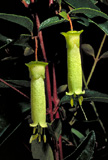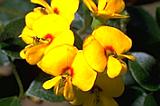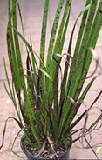|
[Front Page] [Features] [Departments] [SGAP Home Page] [Subscribe]

Electronic Mailbox
 
The following have been selected from the questions received on the SGAP World Wide web site over the past few months. You're welcome to comment on any issue concerning Australian native plants....growing, propagating or appreciating (even loathing!) ... anything.
If necessary, bung a message in a bottle if your net connection goes down!!
....and, if you'd like to contact any of the correspondents and no email address is listed, please feel free to do so through the editor.

Propagation Feedback
I am working with potassium nitrate solution for enhancing seed germination of Australian seeds, using 1 teaspoon per US gallon of water (about 1 teaspoon per 4 litres). Seeds are soaked for 24 hrs and then sown as directed.
I'm also working with the new smoke water treatment for soaking seed, but I must say, the potassium nitrate has worked the best so far in germinating Eucalyptus radiata and Eucalyptus nicholii. KNO3 solution germinated both of the above in 7 days while the smoke water treatment germinated the E.nicholii in 2 weeks with no germination of E.radiata.
Seed came from the same packet for both the KNO3 test and the smoke water test. I'll be doing more testing and let you know what results come up.
Mike Gillespie
USA(?)
Thanks, Mike. Just the sort of feedback that helps extend our knowledge. I'll certainly be interested in hearing about future results and I encourage others to send any interesting results as well.

Plants for a Difficult Position
I hope that you may be able to help me. I have a place on the south side of my house which gets no sun during the winter but direct sun from midday during the summer. The drainage is quite good.
I am looking for plants - preferably Australian natives - which would survive in these conditions.
I hope you have some suggestions.
Audrey
Australia
It's bit of a challenge but there should be some suitable species. The selection will depend on your geographical location but, in eastern temperate areas of Australia, the following would be worth a try.
Most melaleucas (paperbarks) and callistemons (bottlebrushes) will grow in shade and will not be worried by the summer sun. Flowering may be reduced, however, and they would appreciate some water. Tea trees (Leptospermum), such as the lemon-scented tea tree, should also be suitable (avoid the small New Zealand hybrids - many suffer from webbing caterpillar).
Others worth considering are Bauera rubioides (Dog Rose), Correa baeuerlenii (Chef's Cap Correa), Boronia pinnata or Boronia thujona (these are a bit touchy but worth trying if the drainage is good), Mint bushes (eg Prostanthera ovalifolia or P.rotundifolia) Hibbertia scandens, Hibbertia dentatum, Hardenbergia violacea.
 |
Correa baeuerlenii is a rare plant in nature. It is attractive in both foliage and flower.
Select the thumbnail image or plant name for a higher resolution image (27k).
|
The Bird's Nest Fern might also be worth considering if water is available in summer.
There must be many more....can anyone else help Audrey?

Fascinating Fasciation
I would appreciate some help with a prostrate form of Banksia paludosa growing in my garden. It appears to be quite healthy and flowered this year for the first time. It's been in for about three years. Just recently, the new growth has become distorted and unsightly. I took a sample to our last SGAP meeting, and it was suggested that it was called "fasciation", but no one knew much more about it. Is it an infection, viral, insects, or genetic? And should I cut off all the affected material or just leave it to grow on. I've attached a scanned sample of the distorted material. Any suggestions/comments or contacts would be appreciated.
Geoff Warn
Australia
 |
Banksia paludosa showing some definitely unusual foliage!
Select the thumbnail image or plant name for a higher resolution image (55k). Photo: G. Warn
|
John Wrigley has the definitive answer on this.....
"Your plant has a fasciated branch. It will not affect the health of the plant but for appearances sake it is best to cut it off.
Fasciation often occurs on young growth of plants that are growing quickly. The cause is not known for certain and it has been suggested that it may be a mutation, but it may also occur after insect damage or
mite attack.
It is very common over a wide range of species not only native plants. In some cases, for instance cacti and Celosia, it is highly prized by collectors - not my cup of tea!
John Wrigley

Dichondra Problem
Would you please advise me how I can get back my previous Dichondra repens "lawn". It has become sparse over the past few years and all other grasses appear to have dominated it in a back lawn. I recognise that the often dark and daily watered area may not be suitable, however, I have pruned heavily and would like to provide soil additives that will enhance the growth of this great groundcover.
David McLeod
Melbourne, Australia
Mcleod@pa.ausom.net.au
As one who has Dichondra appearing unwanted in many parts of the garden, I'd be more than happy to have it "sparse" (it's not called 'kidney weed' for nothing!). For those who don't know the plant, it's not a grass but a trailing plant with kidney-shaped leaves. It forms roots along its stems and it is often suggested as a lawn substitute.
I passed this one on to John Wrigley, who replied.....
"You are right when you say that Dichondra needs plenty of light. Perhaps your pruning will improve the situation.
I would fork the area well to break the soil surface and ensuring that the soil is moist, sprinkle a high nitrogen lawn fertiliser over it and water it in. You could also take some runners from the existing plants and plant them in the areas that are the sparsest.
I think this treatment should improve things. This is a good time (spring) to do it also.
John Wrigley"

A Mystery Plant
Hello and greetings.
Great web site and a question for you! What is this shrub?
It was grown from seed obtained from a plant at an old family homestead. (South East Queensland)....delicate flower and sweet, slightly pungent fragrance.
Andrew and Yolande Winks
Queensland, Australia
AYWINKS@uq.net.au
 |
Just what do we have here? You can look at a larger picture . . . . but it probably won't help.
Select the thumbnail image or highlighted name for a higher resolution image (37k). Photo: A & Y Winks
|
It's difficult to say as the photo isn't really clear.
It appears to consist of flowers on long stems, possibly with grass-like leaves at ground level. If that's correct, my guess is Haemodorum coccineum, a plant which is related to the Kangaroo Paws.
However, I can't be certain and maybe others might like to have a go!

Propagating Oxylobium
When I left this area of Queensland some 20 years ago, I had quite a few of these plants growing on my property and on my return early this year I was disappointed not to find any on my old property.
However, I have now found two or three of the above plants growing in a paddock near me and I am interested in the propagation of the plant. Do you have any information that could help me do this and do you have any information on their life.
Also there are a number of other pea type ground cover plants on the roadside and I would like to know how I can get these identified and if they too could be propagated. I have a couple of books on wildflowers of
Australia but they do not seem to cover this type of plant.
Bob Rivers
Gympie, Queensland
Because of re-classification within the 'pea' family, many oxylobiums have now been transferred to other genera (Gastrolobium and Podolobium).
As a first step, take a look at the Pea Page and the Propagation Pages.
The Pea Page covers (briefly) cultivation and propagation of pea flowers generally. Generally, most of the pea flowered plants can be propagated from seed using boiling water pre-treatment and cuttings are also successful for many of them.
 |
Oxylobium has flowers typical of the "bush peas". This is Podolobium scandens (formerly Oxylobium scandens)
Select the thumbnail image or plant name for a higher resolution image (25k).
|
As far as identification is concerned, you should probably enquire via the Queensland Region of SGAP...there may be a local SGAP Group in your area who could help or they could probably suggest some other reference.

Problems with Paws....
My wife has planted a kangaroo paw and she seems to be experiencing some difficulty with it.She has planted it in a clay pot with potting soil. She has been watering it frequently and the tips of the leaves have turned black and the black has worked it's way down to the base and they rot and they die. She fertilizes it every two weeks with Miracle Gro.
What she would like to know is how often to water it and how often to fertilize it. How much sun can it tolerate and what can she do about the black rot? Can she use any sprays or other methods to correct this?
Robert L.Poudrier
Oceanside, California
Without seeing the plant it's difficult to be definitive. Some kangaroo paws (mainly the smaller growing types) are susceptible to "Ink Disease" which is caused by a fungus. This spreads from small patches and eventually covers and kills the leaves. It's difficult to cure but you could try drenching the leaves and soil with a strong fungicide and cut back watering drastically. In particular, keep the foliage as dry as possible.
 |
Ink Disease is a debilitating problem with some kangaroo paws.
Select the thumbnail image or plant name for a higher resolution image (31k).
|
I don't think that the plant (even when healthy) needs anything like the amount of fertilizer that has been applied. A dose of slow release fertilizer annually after flowering should be sufficient.
By the way, not all black marks on kangaroo paw foliage is ink disease. Some leaves do get dark streaks naturally without affecting the health of the plant.
I'm not sure if ink disease has crossed the Pacific - perhaps an enquiry at the Santa Cruz Arboretum would be useful or perhaps some of our US readers might know.

Australian Willow
I am the garden coordinator of a school garden in Richmond California. We recently had a donation of two "Australian Willows" or Geijera. I would like to have info about this tree to give to teachers.
Can someone help me track down info about this tree?
Cassie Scott
Verde Elementary School, California
I can try!
There are 7 species of Geijera but I suspect that the one you have is G.parviflora. According to "The Encyclopaedia of Australian Plants" by Rodger Elliot and David Jones, this species "is highly regarded in California, USA, for its willow-like appearance and non-aggressive root system." The form grown in the USA was apparently selected by the Saratoga Horticultural Research Foundation, California.
G.parviflora is known as "Wilga" here....the name "Australian willow" seems to be only used in the USA. It grows naturally in semi-arid areas of Queensland, New South Wales and Victoria. It's a tall shrub to small tree, often with dense foliage to near ground level. It can reach 5-8 metres high by a similar spread. It has clusters of small white flowers in winter/spring. The flowers are said to have a strong odour.
It requires well drained soils and will tolerate alkaline soils. It does best in full sun to part shade.
I hope this helps. Let me know if there is anything else you would like to know.

Grass Tree Propagation
Could you please tell me where I can find information on the Internet on how to propagate grass trees from seed. I have tried a lot of searches, with no luck.
Charee Hansen
Australia
I don't know of any internet site that covers this specifically.
Generally Xanthorrhoea seed is slow to germinate and can take 12 months or more but is sometimes quicker. Some people suggest rubbing the seed between sheets of sandpaper prior to sowing to help water penetration to the embryo. Apart from that there are no other treatments or special "tricks" that I'm aware of.

More Firewheels, Please!
We just wanted to congratulate you on your web site, we found it very informative and easy to access. We were also wondering if maybe you could help us with a query.
We have recently moved into a home with a mature firewheel tree (Stenocarpus sinuatus) and are interested in growing more. We have collected seeds from the tree but are not sure as to the best way to propagate from the seeds. We would appreciate it if you had any suggestions on the best way to go about it.
Lynda and Michael Morgan
Australia
Thanks for the kind words. It's always helpful to get feedback (good or bad)....but I prefer "good"!
The firewheel tree is not difficult to grow from seed using normal methods. You don't need any pretreatment for the seed. General guidelines on propagation from seed can be found on our Plant Propagation pages.
The only problem is that the seedlings can take many years to flower (7 or more) and can be slow growing for the first few years.

[Front Page] [Features] [Departments] [SGAP Home Page] [Subscribe]
Australian Plants online - December 1998
The Society for Growing Australian Plants
|